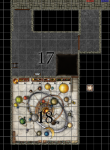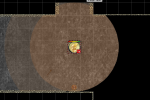Back to the task at hand, the next areas are 17 & 18, both of which are in the same room, which also includes a pit. My stocking roll for 17 indicated an empty room, and my stocking roll for 18 indicated a trap with (hidden) treasure and, well, there is already a pit there, so I stuck the treasure in a niche that can only bee seen from inside the trapdoor pit with the doors closed, or outside the pit by looking through the crack beside the hinges when the door is open.
This makes 14, 15, and 17-18 a bit of a cluster of traps. Moreover, 17-18 in particular isn't very interesting, and unlike 14 & 15 they don't guard a treasure room, like there is no reason they would be there. Looking for inspiration, I rolled on the table for former uses of the space, and came up with "observatory". I searched a bit online for an observatory battle map, and drew a blank (google is increasingly useless). I did a search of my map archive (which is probably where I should have started), and came up with an observatory that fit nicely in the southern part of the room. I have no idea where I lifted that map from.
So I put the observatory map in the southern part of the room, effectively creating two rooms, the north being 17 and the south (observatory) being 18. I moved the pit to be in front of the stairs to the observatory, and added a winch (to retract the observatory doors) and a control panel (which, among other things, locks/unlocks the pit doors) to area 17. I'm now stocking the mostly picked-over observatory with a handful of valuable books (written in Old Sarlonan, which none of the PCs are likely to know), a few ritual/spell books dealing with divination (written in draconic, which some party members are likely to know), and a few potions that haven't evaporated (and some that have decayed and are now toxic). Here is the DM map:

The observatory doors are covered in soil and inoperable unless someone wants to clear it. This meant the observatory is closer to the surface than other parts of the dungeon, so I added a few stairways in the corridors leading to this area.
I now have a backstory for this monastery. It is pre-Galifaran (meaning it is more than 1,000 years old), built by a sect of monks and clerics who were the predecessors to the modern "Restful Watch" sect of the dominant religion in the area, known as the Sovereign Host. The Restful Watch reveres Aureon, the Sovereign god of law and knowledge, but also one of the outcast and presumably evil gods, The Keeper, who is the god of greed, death, and undeath. Despite being heretical in theory, the Restful Watch is accepted in most areas, and commonly used to perform funeral rites which prevent the departed from rising as undead. They frequently have their temples in or near graveyards, and have assumed the task of protecting communities from the undead that often arise in such places.
The southern part of the dungeon is built on a manifest zone, where the walls are thin between the material world and the plane of Mabar, the Endless Night. Undead tends to rise spontaneously here, and wraiths and shadows often cross over from Mabar in order to prey on the living. The monks built the abbey here in order to create and maintain seals that reduce Mabar's influence. However, in the centuries since the abbey was abandoned, the seals have weakened. Cultists of the Radiant Idol have set up a base in the southern part of the dungeon, because it is easier to animate zombies and skeletons here, where Mabar's influence is strong.

 github.com
github.com














